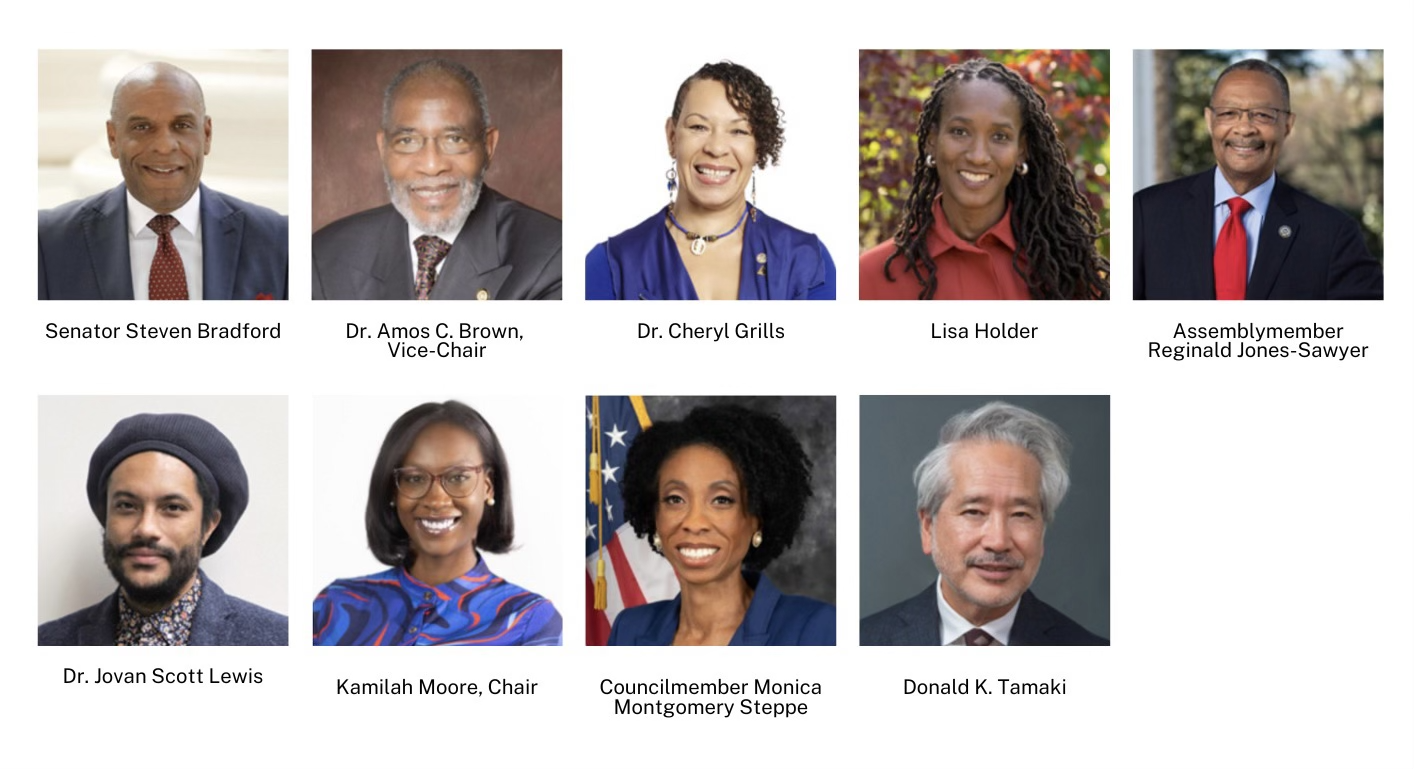Reparations for Black Americans
Redressing the injustices and compounded harms of slavery, segregation, and systemic racism
Over 150 years have passed since slavery was abolished in the United States, and bills at both the federal and state level have been introduced to develop reparations proposals for descendants of African people who were enslaved in the U.S. In 2019, Congresswoman Sheila Jackson Lee sponsored and reintroduced H.R. 40, a bill to establish a commission to study and develop reparations proposals for Black Americans. Aligned with the federal push for reparations, California Assembly Bill 3121 also developed a California Reparations Task Force in September 2020 to study and issue reparations recommendations for Black Californians.
According to William “Sandy” Darity and Kirsten Mullen, authors of From Here to Equality: Reparations for Black Americans in the Twenty-First Century, ‘reparations’ are defined as “a program of acknowledgment, redress, and closure for a grievous injustice.” Discussions on reparations first surfaced at the end of the Civil War, but promises for formal redress were not fulfilled and any attempts to introduce reparations bills in the past often died in the House before ever moving to the Senate for consideration. Regardless, the fight for reparations has continued through the advocacy of Black thought leaders, community leaders, organizers, and policymakers. In 2020, the movement for reparations gained even more traction in response to the murder of George Floyd and the COVID-19 pandemic that disproportionately devastated Black communities. Despite how the compounded economic harm and loss from generations of slavery, colonialism, segregation, and ongoing discrimination cannot be fully monetized, the introduction of reparations bills at both the federal and state level reopens the discussion on formal redress for Black Americans that have been long overdue.
Formal Redress and Expanded Discussions on Reparations Proposals
Nearing the end of the Civil War, Union General William T. Sherman signed Special Field Order 15 on January 16, 1865, which promised to redistribute 400,000 acres of confiscated Confederate land along the coast of South Carolina, Georgia, and Florida to emancipated Black families. This would have allotted 40 acres of land and a mule to 40,000 of the 4 million African people that were subjected to chattel slavery. However, promises were not delivered after Lincoln’s assassination, and another 124 years passed before H.R. 40 was first introduced in 1989 by Congressman John Conyers. This followed the passing of the Civil Liberties Act of 1987, which issued $20,000 reparations checks to Japanese Americans who were forcibly relocated to U.S. internment camps during World War II. While this is not the first instance in which the U.S. government has issued formal redress, Darity, an economist working with the California Reparations Task Force, suggests that the Civil Liberties Act of 1987 is one model for what reparations could look like for Black Americans. Considering that the objective behind a Black reparations program is to eliminate the Black-White wealth gap, “We see no reason for a Black reparations project to be any different,” Darity claims.
Based on a 2016 Survey of Consumer Finances Report, the average white household has a net wealth of $800,000 more than the average Black household. While the issuing of $800,000 payments to every eligible Black American would not entirely remedy the harms and crimes of slavery, this increase in net wealth has the potential to dramatically improve Black educational outcomes, economic security, homeownership, and more. Darity and Mullen estimate this would cost the federal government $10 to $12 trillion at the minimum.
While this is one method of calculating reparations estimates, Darity suggests that the unfulfilled promise of 40 acres of land and a mule could serve as another basis for calculations. If land in the U.S. is conservatively valued at $10 an acre in 1865, and 40 acres were promised to each family of four, that would imply the allocation of 10 acres per person, thus equating to $100 for each person who was formerly enslaved. This value, multiplied by the 4 million people who were formerly enslaved and discounted at a yearly rate of 6 percent (5 percent earned interest and 1 percent inflation) would come out to $1.3 trillion in 2008 dollars. Given that 15 years have passed since Darity’s original estimate, the total amount of reparations in 2023 dollars is expected to be greater. Other researchers have estimated ranges between $500 billion and $6 trillion in total reparations; when divided evenly among the 40 million people who identified as Black on the 2010 U.S. census, this amounts to $12,500 to $150,000 per person in reparations.
Darity and Mullen explain that it is the federal government’s responsibility to pay for reparations. Although many argue that such a large-scale federal expenditure would require the government to raise taxes, the issuance of COVID-19 relief payments in recent years has proved otherwise. Instead, Darity and Mullen caution against the inflationary effects this could yield. To minimize inflation risk, Darity and Mullen advise for reparations payments to be spread out over several years (but for no longer than a decade), and for them to be issued in the form of assets (i.e. annuity, endowment, or trust account), which are less liquid and cannot be spent all at once. This would restrict the amount that recipients would be able to spend at a time, but recipients would still have full discretion over how to spend their funds. With these risks accounted for, reparations have the potential to not only close the Black-White wealth gap, but also to advance racial equity and begin the process of community healing.
Measuring Wealth
The accumulated harm from slavery’s legacy coupled with the country’s racist history of financially excluding Black communities from wealth-building vehicles and institutions has resulted in an enormous wealth gap between Black Americans and other communities. According to the California Reparations Task Force’s interim report, it was estimated in 2019 that the median white household in the U.S. had a net wealth of nine times greater than the median Black household. Net wealth is defined as the total value of assets minus the value of debts.
This wealth gap is even more pronounced at the Los Angeles City level. A survey conducted by the National Asset Scorecard for Communities of Color (NASCC) revealed that Black households in the City of Los Angeles have a median net wealth of $4,000, a stark contrast to white households that have a median net wealth of $355,000. Featured below is a breakdown of median net wealth across white and non-white households in the City of Los Angeles.
Moreover, compared to white households, Black households face extreme barriers to wealth accumulation, leaving many with very little to no financial assets of their own at retirement. This retirement gap is a result of many circumstances, including the fact that Black households are twice as likely to get rejected when applying for a mortgage loan in comparison to white households, even after controlling for credit history and household income. At the federal level, 46% of white families below the age of 35 own their homes, while just 17% percent of Black families in that same demographic do. Furthermore, Black families are far less likely to receive large financial gifts/inheritances and down payment assistance from their parents. Under these circumstances, generating and transferring generational wealth becomes increasingly difficult.
Below is a comparison of assets across different racial and ethnic households in the City of Los Angeles; the data disaggregates the city’s Black population by Black American and Black African immigrants to account for the nuances and differences in their histories. The data indicates higher asset accumulation for Black Africans as opposed to Black Americans, further pointing to the harmful impact slavery has had on Black Americans and their ability to accumulate wealth.
Beyond Wealth
In addition to facing extreme barriers to wealth accumulation, institutional and systemic racism persisting across all institutions and sectors further inhibit Black communities from accessing the resources they need. For example, a study conducted by UCLA looking at 14 school districts in Los Angeles County with populations of 800 or more Black students found that Black students are more likely to come to school hungry and suffer from asthma and respiratory-related illnesses, in addition to being more likely to experience homelessness, poverty, and living in foster care. Furthermore, Black people are overrepresented in both the criminal injustice system and the homeless population, as illustrated in the data below. The relationship between all of these sectors and the various pipelines connecting them thus prove that the harms inherited by Black communities are both intersectional and intergenerational.
Here are areas of disparity that can be explored using the interactive data dashboard below:
A Multifaceted Reparations Program To Amend Multifaceted Harms
Many have argued that the compounded harm Black people have experienced as a result of 250 years of chattel slavery, nearly a century of Jim Crow, redlining, and ongoing systemic racism and structural violence cannot and should not be written off with reparations checks alone. In 2015, the National African American Reparations Commission (NAARC) was developed to fight for reparatory justice, compensation, and restoration of Black communities. The NAARC claims that the compounded harm and loss inherited by Black Americans is multifaceted, hence, solutions and redress should also be multifaceted. That is why their recommendations take the form of a 10-Point Reparations Program consisting of the following:
1. Apology & Maafa Institute
A Formal Apology and Establishment of a African Holocaust (Maafa) Institute.
2. Repatriation
The Right of Repatriation and Creation of an African Knowledge Program.
3. Land
The Right to Land for Social and Economic Development.
4. Funds
Funds for Cooperative Enterprises and Socially Responsible Entrepreneurial Development.
5. Health & Wellness
Resources for the Health, Wellness and Healing of Black Families and Communities.
6. Education
Education for Community Development and Empowerment.
7. Housing & Wealth Generation
Affordable Housing for Healthy Black Communities and Wealth Generation.
8. Info & Comms Infrastructure
Strengthening Black America’s Information and Communications Infrastructure.
9. Sacred Sites & Monuments
Preserving Black Sacred Sites and Monuments.
10. Criminal Justice System
Repairing the Damages of the “Criminal Injustice System”
Overview of California's Statewide Push for Reparations
The California Reparations Task Force is made up of the following members:

Objectives of the Task Force include 1. Studying and developing reparations proposals; 2. Recommending strategies to educate the general public of the Task Force’s findings; and 3. Recommending remedies that align with the Task Force’s findings.
On June 1, 2022, the Task Force issued an interim report to the California Legislature with the objective of surveying the ongoing and compounding generational harms inherited by Black Californians as a result of slavery and its legacy. This interim report was intended to contextualize and justify the case for reparations, but the Task Force has yet to determine the exact details of what reparations will look like and how they will be distributed in California. The Task Force hopes to complete a final report before July 1, 2023, with recommendations for how the California Legislature could remedy these harms.
Before finalizing this recommendation report, the Task Force is holding public meetings throughout the state, with the intention to receive community input and engagement from Black community members. Meetings are held on Fridays and Saturdays from 9 AM to 5 PM PST; they are held both in-person and virtually, and meeting agendas are made available in English and Spanish on the Office of the Attorney General’s website. The Task Force is actively seeking more members from the Black community to participate, especially the youth, who will most likely benefit from a fuller set of reparations. The upcoming reparations bill will impact entire generations of Black people, youth, families, and communities, so it is crucial for the Task Force’s recommendations to be informed by all members of the Black community.
More information on the details and schedule of the Reparations Task Force’s public meetings can be found on the Office of the Attorney General’s website.

Stephanie Liem
Stephanie is a second year Masters in Public Policy student specializing in International Policy at the Sol Price School of Public Policy. She received her B.A. in 2020 from UC Berkeley, majoring in Global Studies with a concentration in Peace & Conflict. She is also a first generation Indonesian immigrant and Asian American activist whose activism revolves around challenging the Model Minority Myth and building Black and Asian solidarity. During the last two years, she worked as a grassroots organizer and Communications Director at an Oakland based non-profit called Hip Hop For Change. Here, she designed her very own Afro-Asian solidarity curriculum, which she has presented at schools, museums, events, and companies across the country. As an academic, her research interests are in ethnic conflict, Southeast Asian politics, and international governance.

Dan Oberle
Dan Oberle is pursuing a Master of Urban Planning degree at The Price School. Prior to his arrival at USC, Dan worked as a documentary film editor in Los Angeles for many years. At USC he hopes to focus on housing and how the built environment influences cities as complex, social-ecological systems. He believes that design and data can be powerful tools to address the hidden inequities embedded in these systems. Dan holds a bachelor’s degree from Florida State University.
Sources
Bhutta, N., et al. (2020). Disparities in Wealth by Race and Ethnicity in the 2019 Survey of Consumer Finances. Board of Governors of the Federal Reserve System. Link
Charles, K.K., & Hurst, E. (2022). The Transition to Home Ownership and the Black-White Wealth Gap. The Review of Economics and Statistics, 84(2), 281–297. Link
Coates, T.N. (2014). The Case For Reparations. The Atlantic. Link
CNBC. (2023, February 8). How To Pay Reparations To African Americans Without Spiking Inflation: Darity, Mullen. YouTube. https://www.youtube.com/watch?v=DN7mYZB3qMc
Craemer, T., et al. (2020). Wealth Implications of Slavery and Racial Discrimination for African American Descendants of the Enslaved. The Review of Black Political Economy, 47(3), 218–254. Link
Darity, W., & Darrity, W. A. (2008). Forty Acres and a Mule in the 21st Century. Social Science Quarterly, 89(3), 656–664. Link
Darity, W. A., & Mullen, A.K. (2020, June 15). Black reparations and the racial wealth gap. Brookings. Link
Darity, W. A., & Mullen, A. K. (2020). From Here to Equality: Reparations for Black Americans in
the Twenty-First Century. University of North Carolina Press. Link
Darity, W.A., & Frank, D. (2003). The Economics of Reparations. American Economic Review, 93(2), 326-329. Link
Education Data Partnership. (2023). Los Angeles Unified. Link
Francis, D. (2020, February 18). The logistics of a reparations program in the United States. Washington Center for Equitable Growth. Link
Francis, D., & Weller, C. (2021). Race, Ethnicity, and Retirement Security in the United States. Oxford Research Encyclopedia of Economics and Finance. Link
Ganti, A. (2023, March 9). Net Worth: What It Is and How to Calculate It. Investopedia. Link
Henry, C. P. (2003). The Politics of Racial Reparations. Journal of Black Studies, 34(2), 131–152. Link
Howard, T., et al. (2019). Understanding the Intricate Linkages between Income, Health, and Wealth for African Americans. Center for Policy Analysis and Research. Link
H.R.40, 2019 116th Congress, 2019, Jackson Lee. (Calif. 2019). Link
Kalish, L. (2022, April 13). California’s reparations task force explained. Cal Matters. Link
La Cruz-Viesca, M.D, et al. (2019). The Color of Wealth in Los Angeles. Duke University, The New School, University of California, Los Angeles, & Insight Center for Community Economic Development. Link
Latal, C. (2021, June 18). The complex case for reparations as H.R. 40 advances. USC Price School of Public Policy. Link
Lofstrom, M, et al. (2021). Racial Disparities in Law Enforcement Stops. Public Policy Institute of California. Link
Los Angeles Homeless Services Authority. (2020) Greater Los Angeles Homeless Count. Los Angeles Continuum of Care (CoC). Link
National African-American Reparations Commission. (2023). About NAARC. Link
National African-American Reparations Commission. (2023). Reparations Plan. Link
Oberle, D. (2022). Resilience and Rebuilding: COVID-19 Recovery in South Los Angeles. Neighborhood Data for Social Change. Link
Office of the Attorney General. (2022). AB3121 Interim Report Executive Summary. Link
Office of the Attorney General. (2022). AB3121 Interim Report. Link
Office of the Attorney General. (2022). AB 3121: Task Force to Study and Develop Reparation Proposals for African Americans. Link
UCLA. (2019). Beyond the Schoolhouse: Digging Deeper: COVID-19 & Reopening Schools for Black Students in Los Angeles. UCLA Center for the Transformation of Schools. Link
USC Price Center for Social Innovation. (2019). Map. Neighborhood Data for Social Change. Link
United States Census Bureau. (2020). Los Angeles County, California. Link
United States Census Bureau. (2020). Los Angeles City, California. Link
Photo Attributions
All photos courtesy of iStock.


